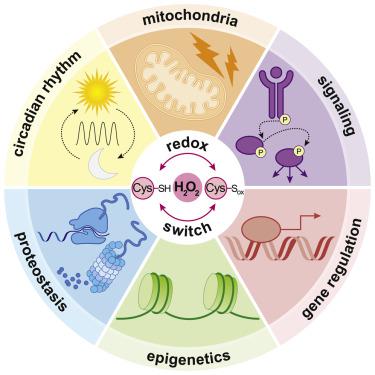Molecular Cell ( IF 16.0 ) Pub Date : 2021-09-21 , DOI: 10.1016/j.molcel.2021.08.018 Claudia Lennicke 1 , Helena M Cochemé 1

|
Redox reactions are intrinsically linked to energy metabolism. Therefore, redox processes are indispensable for organismal physiology and life itself. The term reactive oxygen species (ROS) describes a set of distinct molecular oxygen derivatives produced during normal aerobic metabolism. Multiple ROS-generating and ROS-eliminating systems actively maintain the intracellular redox state, which serves to mediate redox signaling and regulate cellular functions. ROS, in particular hydrogen peroxide (H2O2), are able to reversibly oxidize critical, redox-sensitive cysteine residues on target proteins. These oxidative post-translational modifications (PTMs) can control the biological activity of numerous enzymes and transcription factors (TFs), as well as their cellular localization or interactions with binding partners. In this review, we describe the diverse roles of redox regulation in the context of physiological cellular metabolism and provide insights into the pathophysiology of diseases when redox homeostasis is dysregulated.
中文翻译:

氧化还原代谢:活性氧作为细胞信号传导和功能的特异性分子调节剂
氧化还原反应本质上与能量代谢有关。因此,氧化还原过程对于有机体生理和生命本身是必不可少的。术语活性氧 (ROS) 描述了在正常有氧代谢过程中产生的一组不同的分子氧衍生物。多个 ROS 产生和 ROS 消除系统积极维持细胞内氧化还原状态,其用于介导氧化还原信号传导和调节细胞功能。ROS,特别是过氧化氢(H 2 O 2),能够可逆地氧化靶蛋白上关键的、对氧化还原敏感的半胱氨酸残基。这些氧化翻译后修饰 (PTM) 可以控制许多酶和转录因子 (TF) 的生物活性,以及它们的细胞定位或与结合伙伴的相互作用。在这篇综述中,我们描述了氧化还原调节在生理细胞代谢背景下的不同作用,并提供了对氧化还原稳态失调时疾病的病理生理学的见解。


























 京公网安备 11010802027423号
京公网安备 11010802027423号